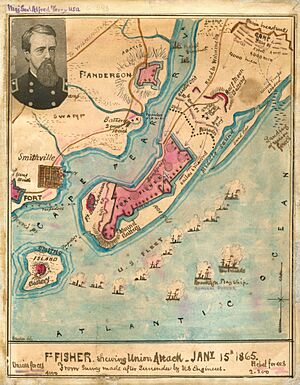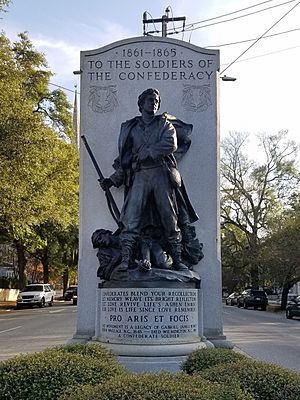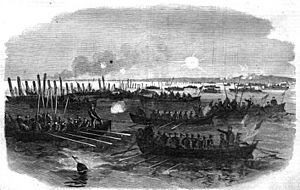Wilmington, North Carolina, in the American Civil War facts for kids


Wilmington, North Carolina was a very important port city for the Confederacy during the American Civil War. It was the last major port on the Atlantic coast to be captured by the Union Army. This happened in February 1865, which completed the Union's plan to block off all Confederate ports.
Contents
Why Wilmington Was So Important
Wilmington was located about 30 miles (48 kilometers) up the Cape Fear River from the Atlantic Ocean. This made it a key city for the Confederacy. In 1860, it had a population of 9,553 people, making it one of the larger cities in the Confederate States.
A Lifeline for the Confederacy
Wilmington was one of the most vital entry points for supplies for the entire Confederacy. The city's port traded valuable goods like cotton and tobacco with other countries. In return, it received important foreign supplies such as munitions (weapons and ammunition), clothing, and foodstuffs. These supplies were crucial for the southern states and especially for General Robert E. Lee's army in Virginia.
The Role of Blockade Runners
This trade depended on fast steamships from British smugglers. These ships were known as blockade runners. They had to sneak past the Union blockade, which was a large and effective naval operation by the Union to stop trade.
The blockade runners usually started their journeys from British colonies like Bermuda, the Bahamas, or Nova Scotia. Besides bringing in essential supplies, these ships also brought foreign sailors. These sailors spent money in Wilmington's local businesses, like bars, hotels, and shops. This made the city feel much more international than it had before the war.
Challenges Faced by Wilmington
In the summer of 1862, a serious health challenge hit Wilmington. Sailors arrived who were sick with yellow fever, a disease common in the Caribbean. An outbreak quickly spread, slowing down activity at the busy waterfront and much of the city. Many people became ill, and some sadly passed away before the disease ended.
After the city of Norfolk, Virginia fell to Union forces in May 1862, Wilmington's importance grew even more. It became the main Confederate port on the Atlantic coast. Wilmington's defenses along the Atlantic shore were very strong. Only Charleston in South Carolina had stronger forts. Wilmington managed to resist Union capture for a long time, mostly because of a powerful fort called Fort Fisher.
Blockade running became a well-organized business. For example, the Crenshaw Company arranged for cotton to be sent from inside the Confederacy to Wilmington. From there, it was smuggled through the blockade to England.
The Fall of Wilmington
Wilmington was finally captured by Union forces on February 22, 1865. This happened about a month after Fort Fisher had fallen. The Battle of Wilmington involved a few smaller fights near the Cape Fear River. These battles led to the Confederate forces, led by General Braxton Bragg, leaving the city. Before they left, General Bragg ordered large amounts of cotton and tobacco to be burned. This was to prevent these valuable goods from falling into Union hands. Maj. Gen. Jacob D. Cox led the first Union troops into Wilmington. His forces then occupied the city for the rest of the war.
Because most of the fighting happened outside the city, many beautiful old homes and buildings from before the war still stand in downtown Wilmington today.
Escape to Freedom in 1862
The Civil War brought many changes and dangers to Wilmington, including more crime and the threat of invasion. Because of this, many slave owners moved inland, which meant less direct control over the people they enslaved.
On a rainy night, September 21, 1862, William B. Gould and George Price made a brave escape. They, along with six other enslaved men, rowed a small boat about 28 nautical miles (52 kilometers) down the Cape Fear River. They started their journey from Orange Street, very close to where Gould lived. There were guards along the river, making their escape even more dangerous. They had a sail on their boat, but they waited until they were safely out in the Atlantic Ocean before raising it. This was to avoid being seen.
As dawn broke on September 22, they reached the Atlantic Ocean near Fort Caswell and raised their sail. There, the USS Cambridge, a ship from the Union blockade, picked them up. They were considered "contraband," which meant they were formerly enslaved people who had escaped to Union lines. Other Union ships in the blockade also picked up two more boats carrying friends of Gould. It's possible this was a planned escape involving several groups. What they didn't know was that just an hour and a half after their rescue, President Abraham Lincoln was meeting with his advisors to finalize plans for the Emancipation Proclamation. This important document would declare many enslaved people free.


